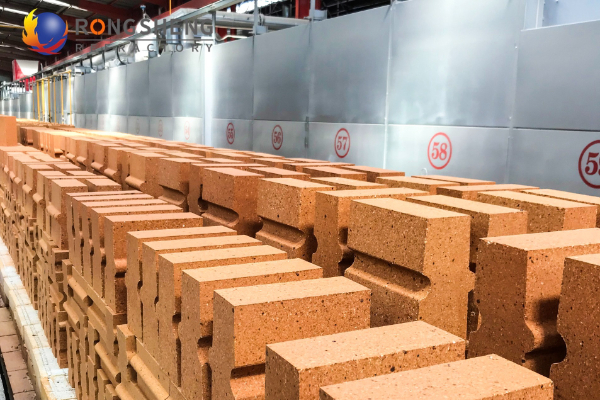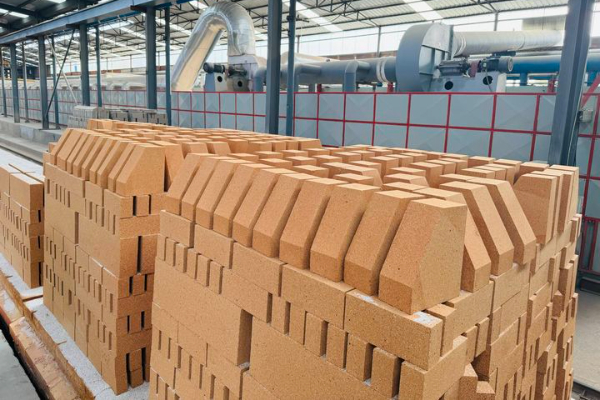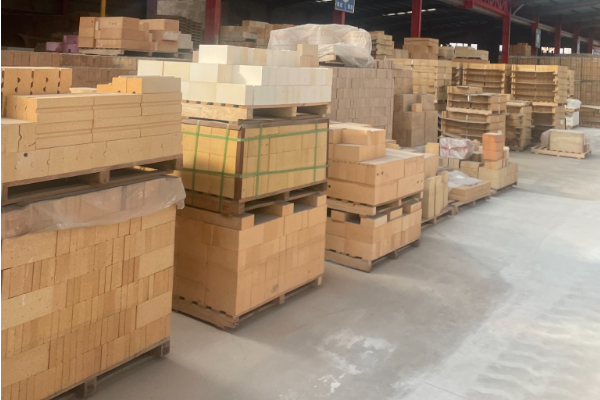점토 내화 벽돌 생산 공정 소개
점토 내화 벽돌은 일반적으로 사용되는 내화물입니다., 철강 등 고온 공업용로에 널리 사용, 유리, 시멘트, 그리고 도자기. 내열충격성이 우수합니다., 고온 강도, 화학적 안정성. 이 기사에서는 내화 점토 벽돌의 생산 공정을 자세히 소개하여 모든 사람이 이 중요한 내화 재료를 더 잘 이해할 수 있도록 돕습니다..

점토 내화 벽돌 생산 공정
① 원료 준비
주로 클링커의 제조 및 접착점토의 제조. 클링커의 제조는 내화성 점토 원료를 고온에서 하소하여 클링커를 만드는 것입니다., 그런 다음 분쇄, 화면, 이를 다양한 수준의 입상물과 미분말로 분쇄합니다.. 접착 점토의 준비는 분쇄하는 것입니다, 마른, 잘게 분쇄하다, 그리고 점토를 슬러리로 만드세요. 점토 클링커는 대략 50mm 이하의 블록으로 분쇄된 후 5~2mm의 다양한 수준의 집합체로 분쇄됩니다.. 체질된 재료는 기계에 들어가 0.5mm 미만의 미세한 분말로 분쇄됩니다.. 접착 점토는 일반적으로 건조됩니다., 그리고는 대충 으깬다, 분쇄된, 0.5mm 이하의 미세한 분말로 분쇄한 것입니다., 또는 클링커와 혼합하여 고운 가루로 만들거나.

② 배치 및 혼합
일괄 처리, 혼입, 그리고 성형: 하소된 내화성 점토 클링커가 희박 물질로 사용됩니다., 그리고 일정 비율의 결합 점토를 첨가하여 혼합물을 만듭니다.. 클링커는 혼합물에서 높은 비율을 차지합니다., 멀티클링커 제품이라고 불리는데요. 이런 종류의 제품은 높은 볼륨 안정성과 기타 우수한 특성을 가지고 있습니다., 하지만 강하게 성형해야 해요. 현재, 멀티클링커 벽돌은 가장 널리 생산되고 사용되는 제품입니다.. 혼합물을 혼합한 후 성형하거나, 트랩한 후 혼합한 후 성형하는 것. 성형방법은 여러가지가 있습니다, 그러나 현재 멀티클링커 제품에는 세미드라이 프레싱 성형 방식을 사용하고 있습니다.. 성형 압력은 밀도에 영향을 미칩니다., 구조적 강도, 벽돌의 슬래그 저항성.
진흙의 비율에는 클링커 사이의 질량비와 입자 비율이 포함됩니다., 바인더 점토, 물, 및 첨가제. 성형방법에 따라 바인더 클레이와 물의 첨가량이 달라집니다.. 플라스틱 성형 비율은: 수갑: 점토는 (7-5): (3-5), 그리고 수분 함량은 16%-20%; 반건식 성형 비율은: 수갑: 점토는 (9-7): (1-3), 그리고 수분 함량은 3.5%-8.0%. 다양한 입상 재료가 혼합 장비에 순차적으로 추가됩니다., 그리고 다양한 바인더를 첨가하여 균일한 진흙을 만듭니다..
③ 점토 내화벽돌 벽돌 건조
건조된 점토 벽돌 블랭크의 수분 함량은 성형 방법에 따라 다릅니다.. 반건식 프레싱 성형으로 블랭크의 수분 함량이 낮습니다.. 수분이 증발하면, 수축이 거의 없어요. 신속하게 건조되거나 가마에 직접 적재될 수 있습니다.. 수분 함량이 높은 벽돌 블랭크를 적절한 자연 건조 또는 열풍 가열로 미리 건조시킨 후 터널 가마로 보낼 수 있습니다.. 건조 과정을 제어하는 핵심 요소는 건조 속도입니다.. 블랭크가 변형되지 않도록 하는 것이 원칙입니다., 금이 가다, 그리고 일정한 힘을 가지고. 최종적으로 소성가마에 들어가는 블랭크의 수분함량은 이하로 조절됩니다. 2%.

④ 점토벽돌 소성
소성의 목적은 벽돌을 소결하여 특정 치수를 부여하는 것입니다., 다공성과 밀도, 높은 기계적 강도, 좋은 볼륨 안정성, 그리고 좋은 내화성. 발사 과정에서, 벽돌의 매트릭스는 일련의 물리적, 화학적 변화를 겪습니다., 하강기류나 터널에서는 다양한 반응이 일어나게 됩니다.. 소성과정은 크게 4단계로 나누어진다.
- 온도가 200℃에 도달하면, 압분체가 갈라지는 것을 방지하기 위해 온도를 너무 빨리 올리면 안 됩니다.. 터널 가마에서 소성할 때, 첫 번째 온도 4 주차 공간은 200°C를 초과해서는 안 됩니다..
b.200-900℃ 이 단계에서는 빌렛의 유기물과 불순물의 화학 반응을 촉진하기 위해 온도 상승을 가속화해야 합니다.. 600-900℃ 기간 동안, 강한 산화 분위기는 가마 내에서 유지되어야 합니다. “블랙 코어” 폐벽돌. - 900-1380℃: (고온 단계에서는 온도 상승이 안정적이어야 합니다., 벽돌 몸체가 고르게 가열되고 벽돌 몸체의 균열을 방지하려면 산화 분위기가 유지되어야합니다.. 1100℃ 이상의 고온에서 발생하기 때문에, 소결 수축이 매우 강하다, 그리고 수축율은 도달합니다 5%, 따라서 온도 구배를 완만하게 유지하고 내부 응력을 제거하는 것이 매우 중요합니다..
- 점토벽돌의 방화온도는 일반적으로 소결온도보다 100~150℃ 높다.. 사용되는 소결점토의 소결온도 범위가 좁은 경우, 방화온도는 더 낮아야 한다, 약 50-100℃가 더 적합합니다.. 점토 제품의 소성 온도 클링커 입자를 결합시키고 제품이 적절한 강도를 얻도록 하기 위해서는 결합 점토가 완전히 연화되어 클링커 미세 분말 및 조립자 표면층과 완전히 반응할 수 있도록 보장해야 합니다. 볼륨 안정성. 소성 온도는 일반적으로 1250-1350℃입니다.. A1203 함량이 높은 경우, 제품의 소성온도를 적절하게 높여야 합니다., 약 1350-1380°C, 소성 보온 시간은 일반적으로 2-10 제품 내 반응이 충분하고 제품의 표면 및 내부 품질이 일관되는지 확인하는 데 몇 시간이 소요됩니다..
- 냉각 단계에서, 냉각부에서 제품의 격자 변화에 따라, 1000°C 이상의 고온에서는 온도를 급격하게 올려야 합니다., 1000-800°C에서는 냉각 속도가 느려져야 합니다.. 사실은, 실제 생산 중, 실제로 채택된 냉각 속도는 제품의 냉간 균열 위험을 유발하지 않습니다..
 Rongsheng 내화물 공장
Rongsheng 내화물 공장
위챗
위챗으로 QR코드 스캔